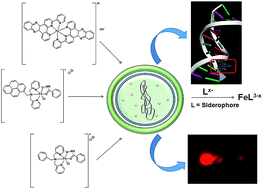Bacterial siderophore mimicking iron complexes as DNA targeting antimicrobials†
Abstract
Microbial secretion of siderophores for iron uptake can be employed as an efficient strategy to smuggle in bactericidal agents by conjugation to iron. Three iron complexes: complex 1 [Fe(L1)2]Cl2 L1 = 3-(pyridin-2-yl)dipyrido[3,2-a:2′,3′-c]phenazine (pydppz or ligand 1), complex 2 [Fe(BHA)(L2)Cl]Cl·H20 (BHA = benzohydroxamate) L2 = pyrenyl-dipicolylamine (pydpa or ligand 2) and complex 3 [Fe(BHA)(L3)Cl]Cl·H20 L3 = phenyl-dipicolylamine (phdpa or ligand 3) were synthesized. The ligands were docked for binding to DNA and DNA polymerase I. The antibacterial efficacy of the iron complexes were evaluated against three pathogenic bacteria – Staphylococcus aureus (MRSA), Escherichia coli and Pseudomonas aeruginosa as well as cytotoxicity assessed in C2C12 mouse myoblast cells. In silico docking and molecular dynamic simulations of the ligands revealed stable and non-specific binding to DNA and DNA polymerase I, in the order: L1 > L2 > L3. The bactericidal effect of the iron complexes against MRSA predominantly occurred by bacterial DNA fragmentation as analyzed from gel electrophoresis and comet assay. The extent of DNA damage followed the order: complex 1 > complex 2 > complex 3, in commensurate with docking. Siderophore production elicited preferential bactericidal action of the iron complexes against MRSA. Both, complex 1 and complex 2 were 5–10 fold less toxic in C2C12 cells compared to MRSA. Taken together, a combination of DNA targeting and siderophore mimicking ligands conjugated to iron can be deployed as Trojan horse for the entry of antimicrobials into pathogenic bacteria. Thus, DNA targeting antimicrobials offer a promising solution to persistent bacterial infections. Their selectivity towards microbes can be promoted via siderophore uptake pathways.


 Please wait while we load your content...
Please wait while we load your content...